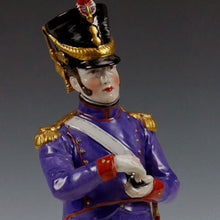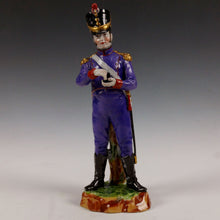Officier, Artillerie a Pied de la Garde, 1805
- Regular price
- £1,200
- Sale price
- £1,200
- Regular price
-
- Unit price
- /per
Adding product to your cart
Height: 27cm (10.5in)
Early 20th Century
SAXON MILITARY PORCELAIN FIGURES
Of the numerous European porcelain factories that produced military figures during the 19th and 20th centuries, Sachsische Porzellan Manufaktur Dresden (the Dresden factory) stands out as the finest producer in terms of sculpting and painting.
The factory was founded in 1872 by Carl Thieme, an antiques dealer and porcelain retailer who employed porcelain workers from the bankrupt Buxdorf manufactory. By the 1890’s it was under the management of Karl August Kuntzsch, a talented modeller and employee of the Thieme family. Kuntzsch introduced the factory’s wares to foreign markets and it was under his tenure that the production of military figures began in 1912, with the series of French Napoleonic subjects, the first of these being an equestrian figure of Napoleon (an example of which may be seen at Winston Churchill's former home, Chartwell in Kent). However, owing to the antipathy between France and Germany arising from the war of 1870, these early pieces were often marked underneath with the signature of the French Imperial Sevres factory, presumably at the insistence of French retailers to disguise their German origins. In 1913 a series of Italian historical and military figures followed.
Read more
Between 1912 and 1914, with the 100th anniversary of the Battle of Waterloo approaching, the London retailer Thomas Goode & Co., of Mayfair planned to offer a series of figures representing the British regiments of Wellington's allied army. A number of these specially marked, and now rare figures were imported from Saxony into England prior to the Waterloo centenary, but with the outbreak of war in August 1914 steps were taken by Goode and other retailers to disguise the German origins of these figures by covering Dresden factory marks or ascribing them to English porcelain manufacturers, such as the ceramic manufacturer Copeland Spode, which produced a parallel if marginally inferior series of British figures at that time.
At the start of the First World War, the Dresden factory continued its production of military porcelain figures with the introduction of German subjects to emphasize the Prussian martial tradition and the German contribution to the Grand Alliance against Napoleon.
There appear to have been no additions to the military figures until 1929 when the factory's chief sculptor, Reinhold Braunschmitt introduced the series representing the uniforms of the three senior regiments of British Foot Guards from 1660 to 1930. It has been suggested that these figures were the result of a collaboration between Major E.G. Christie-Miller (1880-1967) and Karl August Kuntzsch’s two sons who succeeded him in running the factory in 1920. Christie-Miller was a Coldstream Guards officer with a strong sense of regimental tradition. He was a prisoner of war from 1914 to 18 and upon his release had been commissioned to tour the country and report on conditions in Germany. Accordingly his command of German allowed him to fully communicate his ideas to Braunschmitt and his superiors. The results of their efforts were a fine range of Guards figures for retailer Fortnum & Mason, which may be seen as the high water mark of their military figure production.
The success of these figures resulted in the creation of a further range of figures for the British market designed by Braunschmitt and fellow sculptors Josef Dobner and Fritz Schlesinger (fl. 1928-38), and reflecting the history of the Royal Navy during the 18th and 19th centuries. The coronation of George VI in 1937 provided the Kuntzsch brothers with a substantial order from the British court for their traditional wares and corresponding additions to the existing range of military and ceremonial figures. These included officers of the Life Guards, Royal Horse Guards, Irish Guards, Welsh Guards, Ulster King of Arms, and members of the Honourable Corps of Gentleman-at-Arms and the Royal Company of Archers (Sovereign’s Bodyguard for Scotland). However state interference in all areas of economic production impacted on the factory in 1936 when the use of gold was disallowed on the edges of cups, bowls, boxes, vases and presumably all military figures. An inconspicuous gold-brown color was used as a substitute, which has been seen on French Napoleonic figures.
After 1945, Emil Alfred Kuntzsch slowly restarted production, but came under pressure from Communist officials to submit the business to state ownership. His resistance resulted in his arrest on trumped up charges of criminal economic activity in 1950. The factory was held in trust until 1971 when it became part of a group of state controlled manufacturers. Lack of direct contact with informed retailers in the U.K. and the passing of the skilled military figure painters who had worked at the factory in the heyday of the 1930's coincided with a general decline in the standards of production. In 1972 a number of British military figure moulds, including those of the Guard








